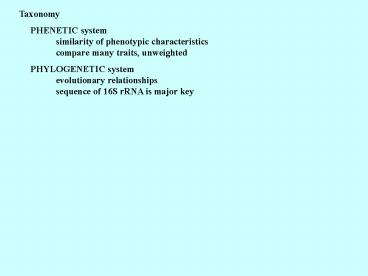Taxonomy PowerPoint PPT Presentation
1 / 26
Title: Taxonomy
1
Taxonomy PHENETIC system similarity of
phenotypic characteristics compare many traits,
unweighted PHYLOGENETIC system evolutionary
relationships sequence of 16S rRNA is major key
2
NOMENCLATURE Binomial nomenclature
Genus and species e.g. Homo sapiens
Classification Heirarchy Kingdom Phylum
Class Order
Family Genus
Species Strains biovars
morphovars serovars
3
NOMENCLATURE Classification
Heirarchy Domain new term Phylum
Class Order
Family Genus
Species Strains Domains
Eukarya Bacteria Archaea
4
CLASSIFICATION - 5 Kingdoms (Whittaker,
1969) Prokaryotae or Monera Protista Fungi P
lantae Animaliae CLASSIFICATION - 3
Kingdoms (Woese, 1978) Eubacteria -
true bacteria Archaebacteria - ancient
bacteria Eukaryotes - protists, fungi, plants,
animals
5
BASICS OF CLASSIFICATION Morphological
Characteristics cell shape cell
size colony appearance flagella arrangement
6
BASICS OF CLASSIFICATION Staining
Properties Gram stain Acid-fast
stain Structural stains endospore, flagella,
capsule
7
BASICS OF CLASSIFICATION Physiological
Properties C and N sources energy sources cell
wall constituents pigments fatty acid
composition
8
BASICS OF CLASSIFICATION Ecological
Characteristics symbiotic relationships ability
to cause disease temperature relationships pH
optimum oxygen requirements
9
BASICS OF CLASSIFICATION Genetic
characteristics ability to exchange DNA
-transformation, conjugation,
transduction phage susceptibility plasmids -
can they harbor the same ones nucleotide
sequences
10
BASICS OF CLASSIFICATION Molecular
characteristics proteins and genes from
which they came amino acid sequence and DNA
sequence G C content ( Tm)
hybridization (DNA-DNADNA-RNA)
11
BASICS OF CLASSIFICATION Molecular
characteristics proteins and genes from which
they came amino acid sequence DNA sequence G
C content Tm hybridization DNA - DNA, DNA -
RNA RNA sequence and structure 5S and 16S rRNA,
tRNA
12
Bergeys Manual of Determinative
Bacteriology Eight editions Bergeys Manual of
Systematic Bacteriology 1st ed Phenetic
classification system four volumes
13
Bergeys Manual of Systematic Bacteriology - 2nd
ed emphasis on 16S rRNA sequence phylogenetic
classification Vol. 1 Archae Deeply
Branching Phototrophic Bacteria Vol. 2
Proteobacteria Vol. 3 The Low GC
Gram-positive Bacteria Vol. 4 The High GC
Gram-positive Bacteria Vol. 5 The
Planctomycetes, Spirochaetes, Fibrobacteria Bact
eroidetes Fusobacteria
14
Bergeys Manual of Systematic Bacteriology - 2nd
ed
15
Bergeys Manual of Systematic Bacteriology - 2nd
ed
16
Bergeys Manual of Systematic Bacteriology - 2nd
ed
17
Archae or Archaebacteria classification base
d on rRNA data, physiology, morphology Bergeys
1st ed five groups Bergeys 2nd ed two
phyla Euryarchaeota eurus wide archaios
ancient widely distributed metabolically
diverse
18
Archae or Archaebacteria classification base
d on rRNA data, physiology, morphology Bergeys
1st ed five groups Bergeys 2nd ed two
phyla Euryarchaeota eurus wide archaios
ancient widely distributed metabolically
diverse Crenarchaeota crene spring or
fount archaios most thermophiles or
hyperthermophiles most acidophiles and sulfur
dependent S used as e- source in some,
acceptor in others most strict
anaerobes thought to resemble ancestors of
Archae
19
Archae or Archaebacteria diverse in
morphology rods, cocci, spirilli, irregular
shape, pleomorphic single cells to filaments to
aggregates range from 0.1 to more than 15 µm
(filaments to 200 µm) Gram-positive and
Gram-negative organisms replication by binary
fission, budding, fragmentation, etc.
diverse in physiology aerobic to facultative to
anaerobic mesophiles to hyperthermophiles (grow
above 100C) recently found in coastal
Antarctic waters diverse in nutritional
requirements chemolithotrophs ot organotrophs
often found in extreme environments anaerobic,
saline, high temperature
20
Archae or Archaebacteria cell walls differ
in composition and structure lack muramic acid
and D-amino acids Methanobacterium and
some methanogens pseudomurein L-amino acids,
N-acetyltalosaminuronic acid
Methanosarcina Halococcus complex
polysaccharide like chondroitin sulfate
Gram-negative archae glycoprotein or protein,
some 20-40 nm thick
21
Archae or Archaebacteria cell membranes
contain ether-linked lipids hydrocarbons are
20-40 C in length C hydrocarbons
based on isoprene C-C-C-C cyclopropan
e rings may be present polar lipids also
present phospholipids, sulfolipids and
glycolipids non-polar lipids also present -
7-30 of lipids derivatives of squalene
22
Archae or Archaebacteria cell membranes
23
Archae or Archaebacteria genetics molecular
biology genome single, circular DNA
smaller than normal bacteria 0.8-1.1 X 109 E.
coli - 2.5 X 109 few plasmids
Methanococcus jannaschii genome sequenced over
50 of its 1738 genes unlike bacteria and
eukaryotes mRNA similar to bacterial mRNA
polycistronic, no splicing promoters similar to
bacterial promoters initiator tRNA carries
methionine like eukaryotes
24
Archae or Archaebacteria genetics molecular
biology ribosomes 70S but shape variable
different from bacteria resemble eukaryotic in
antibiotic sensitivity sensitive to
anisomycin insensitive to chloramphenicol
kanamycin elongation factor 2 (EF-2)
sensitive to diphtheria toxin similar to
eukaryotic EF-2 DNA-dependent RNA polymerase
resemble eukaryotic form large enzyme
complexes insensitive to rifampin and
streptolydigin
25
Archae or Archaebacteria metabolic pathways
varied modified Entner-Doudoroff path in
some all convert pyruvate to acetyl-CoA
dont have enzyme like bacteria or
eukaryotes some have functional TCA cycle and
respiratory chains
26
Archae or Archaebacteria Bergeys 1st
edition five groups

